How to Build a Keyboard Out of Grass Clippings and Hope
So, you want to build a keyboard out of grass. Yes, actual, living grass. It sounds like something from a fantasy novel, but it's totally possible. This is your guide to the Terraboard, the keyboard that you have to water.
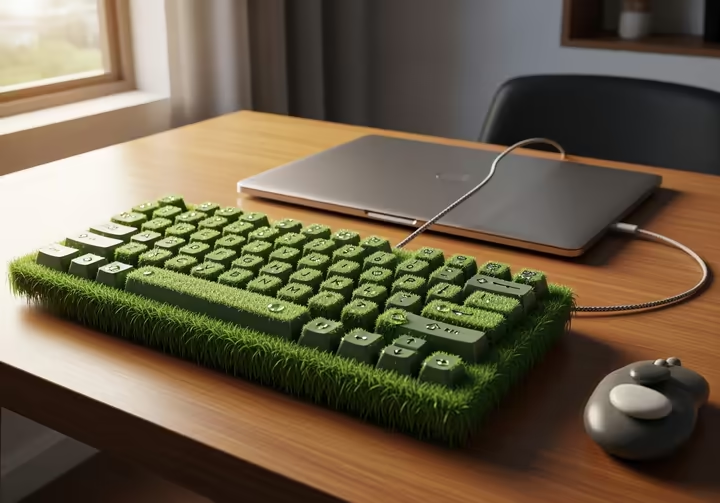
How Does a Grass Keyboard Even Work?
The Terraboard works by turning the natural electricity in plants into computer signals. It sounds like pseudoscience, but the basics are grounded in real biology. Let’s get into it.
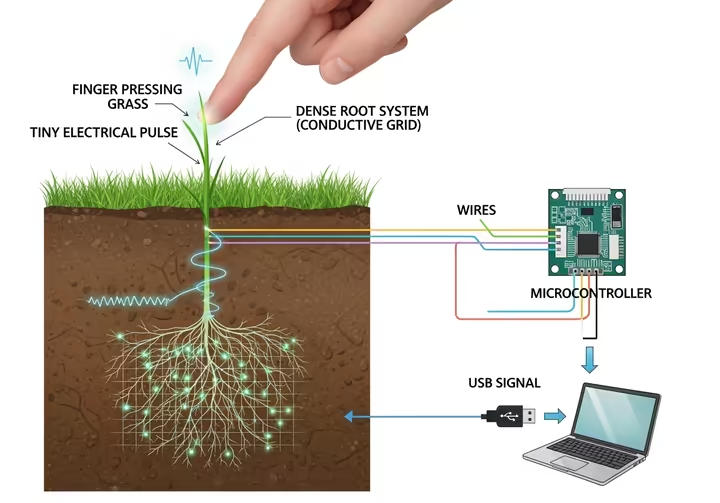
Plants are Electric
All living plants use tiny electrical signals to do... well, plant stuff. Instead of electrons flowing through copper wire, plants move charged ions around to communicate. This creates tiny electrical currents that control everything from how they grow to where they send nutrients.
Plants also send out bigger electrical pulses when they’re stressed, like when you press on a blade of grass. A keystroke is just a poke that sends a little 'zap' through the grass. This is the basic signal the keyboard uses.
The Photosynthesis Button
Photosynthesis is basically a tiny solar-powered battery in every leaf. Within each plant cell, a process converts sunlight into chemical energy by pumping protons around. This creates an electrical charge, like a tiny battery.
When you press a blade of grass, you gently squeeze its little power-making parts. This squeeze causes a tiny, controlled leak of protons, creating a measurable electrical pulse, the raw signal of a keystroke. The signal strength depends on how much sunlight the grass is getting, which is why the keyboard feels crisper on a sunny day.
Roots as Wires
You don't need a plastic printed circuit board (PCB), you have roots! Certain grasses, like Kentucky Bluegrass, grow a dense, grid-like mat of roots just under the soil. This mat acts like the wiring grid on a normal keyboard.
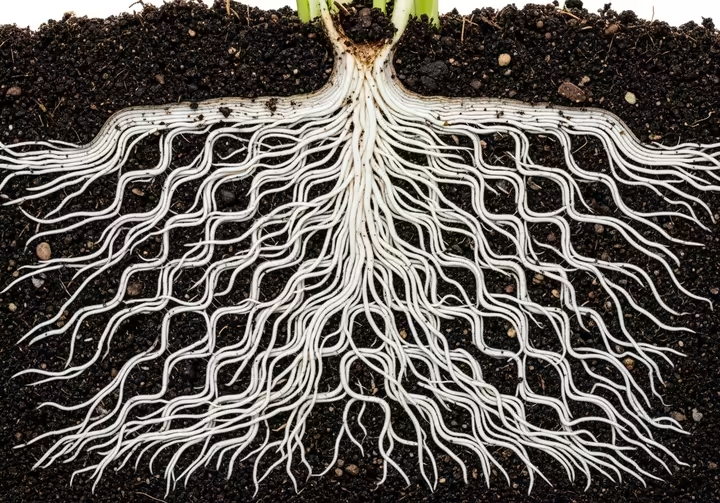
When a signal is generated in a blade of grass, it travels down into the root grid. A connected microcontroller can then tell exactly which 'key' was pressed based on where the signal came from. Some builders even mix grasses, using tough Ryegrass for the WASD keys and Bluegrass for the rest of the grid.
Why Doesn't It Short-Circuit?
Wet dirt and electricity sound like a bad mix, right? But here, the entire bed of soil acts as a ground. The specific soil mix, a type of loam, absorbs stray signals so your keystrokes don't get mixed up.
The planet Earth itself, with its huge electrical capacitance, provides a stable ground reference for the controller. So, you’re basically plugging your keyboard into the ground. No, seriously.
| Grass Specs | ||||
|---|---|---|---|---|
| Grass Species | Photosynthetic Current Potential (µA/lumen) | Root Matrix Conductivity (mS/cm) | Tactile Feedback Index (TFI) | Optimal pH for Signal Integrity |
| Kentucky Bluegrass ( Poa pratensis ) | 1.8 | 0.75 | 4.2 | 6.5 - 7.0 |
| Perennial Ryegrass ( Lolium perenne ) | 2.1 | 0.12 | 7.8 | 6.2 - 6.8 |
| Heirloom Fescue ( Festuca spp. ) | 1.5 | 0.45 | 6.5 | 6.0 - 6.5 |
Building Your Own Terraboard
Building a Terraboard takes the skills of an electronics hobbyist and the patience of a gardener. Each step is important for getting a working keyboard.
Potting the Motherboard
First, pick a case. A terracotta tray is great for keeping the roots cool. A reclaimed oak frame can give it a nice, deep sound profile.
Then, mix your soil. The best mix for electrical performance is a loam made of 40% sand, 40% silt, and 20% clay. Add some vermiculite to keep it from getting compacted, and make sure the pH is balanced. It's like baking a very nerdy cake.
Planting the Keys
Time to plant. To get a perfect keyboard layout, use a 3D-printed seeding stencil. You can find files for standard ANSI and ISO layouts online.
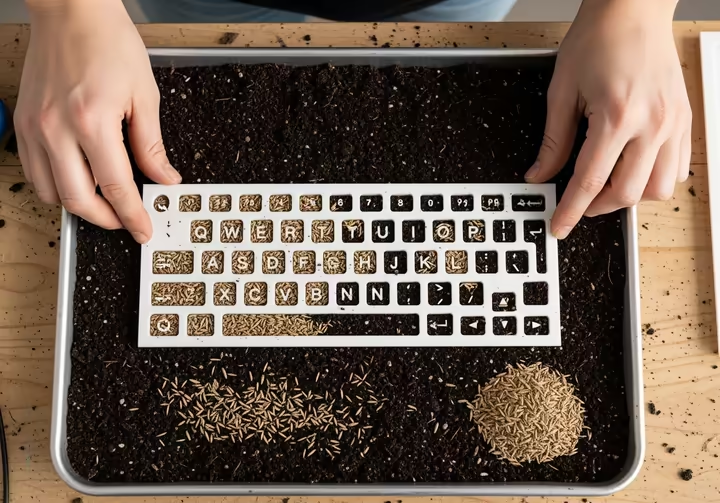
(Caption: A 3D-printed seeding stencil, essential for getting that perfect QWERTY layout.)
Drop 5-7 seeds in each hole to get a dense "keycap" feel. Once you're done, remove the stencil and sift a thin layer of soil over the seeds.
Growing the Firmware
Now, we wait. For about six to eight weeks, keep the tray in a spot with consistent temperature and at least 12 hours of light a day. Water it daily.
As the grass sprouts, place a fine grid just over the soil. This "training lattice" forces the blades to grow straight up through specific holes. This creates separate keys instead of one big lawn.
Hooking Up the Wires ("Sod-ering")
This is the trickiest part. You’re not using a soldering iron, you’re using a sterilized grafting knife to connect the root grid to the microcontroller.
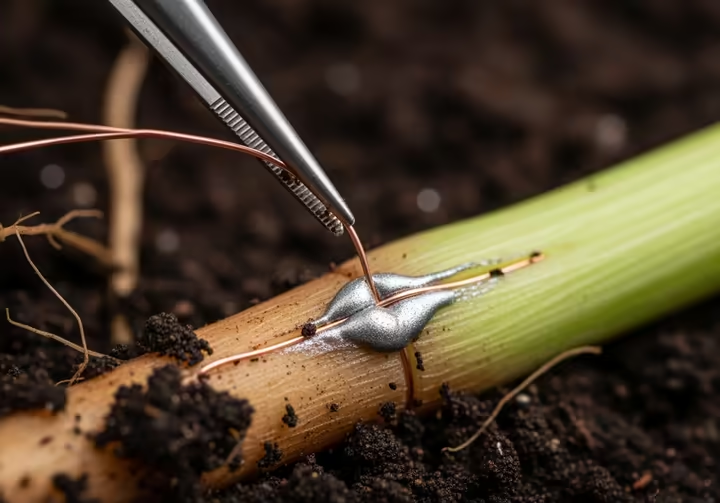
(Caption: The delicate process of 'sod-ering', connecting a copper wire directly to a living root.)
You'll carefully expose a main root for each row and column, make a tiny cut, and insert a tinned copper wire. A special conductive nutrient paste seals the deal and helps the root heal. Repeat this for every connection to your controller (like a Teensy), and the circuit is complete.
What You'll Need
Building a Terraboard requires a weird mix of stuff from the electronics store and the garden center. Here's a quick rundown.
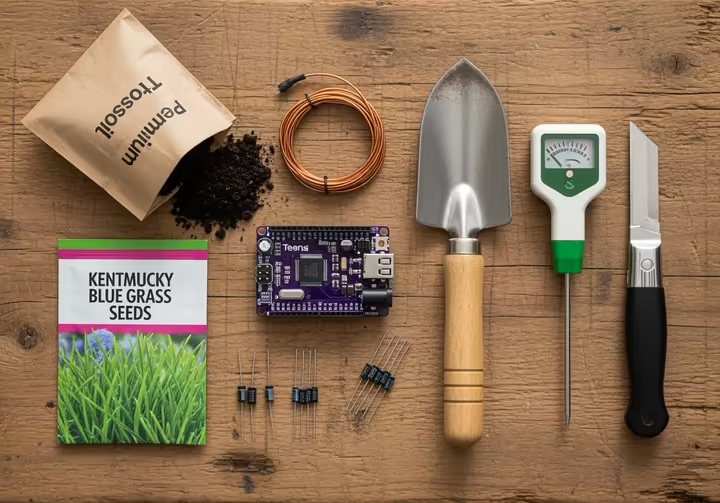
The electronic heart is a QMK-compatible microcontroller, a Teensy 2.0 is a good choice. You'll also need diodes (one for each key to prevent 'ghosting'), a USB-C breakout board, and some 22-gauge copper wire.
For the living parts, you'll need about 5 lbs of good topsoil. Choose your seeds wisely, Heirloom Fescue has a nice feel, while Kentucky Bluegrass has better roots for the grid. For watering, you can use purified morning dew... or just clean tap water, we won't tell.
Your toolbox will be strange. You'll need a soldering iron (for the wires) and a sterile grafting knife (for the roots). You'll also need a multimeter, a garden trowel, sharp pruning shears for trimming your 'keycaps', and a soil moisture meter. Oh, and a single, unwavering ray of hope. This project is tough.
The Grass Keyboard Scene
A small but passionate subculture has popped up around building the perfect Terraboard. They treat it as a serious mix of engineering and art.
The Purists
These are the hardcore fans. They use 100% biodegradable parts, like unsealed terracotta cases and bare copper wires that get a nice patina over time. For a Purist, the keyboard eventually decomposing and returning to the earth isn't a bug, it's a feature.
The Great Debate: Living Sod vs. Clippings
The biggest argument in the community is the "Living Sod vs. Clippings" debate. The Living Sod folks say the whole point is the dynamic, changing feel of a real, living plant. The "Clippings" faction takes a different approach.
They harvest and cure grass clippings, then put them in traditional resin keycaps. They claim this gives a "crispier" and more consistent feel, with a dry "rustle" sound. It's the "thock vs. clack" of the grass keyboard world.
Community Jargon
The community has its own lingo. "Thatch" is the layer of dead stuff that builds up and makes the keys feel "mushy." "Mowing" is trimming the grass blades to a uniform height, just like choosing a keycap profile.
"Seasonal drift" is how the keyboard's performance changes from summer to winter as the light changes. And a total failure, like when you overwater the whole thing? That's called "root rot," the plant equivalent of a fried PCB.
Troubleshooting Your Lawn
When you mix gardening with electronics, you get some very weird problems. Here are a few common ones.
Q: My spacebar is yellowing and won't work. What's wrong?
A: Yellowing (chlorosis) in a high-use key usually means it's short on nitrogen. But don't just dump fertilizer on it! First, check the electrical signal with a multimeter. If the signal is weak, a spritz of liquid fertilizer with iron, applied right on the blade, should fix both the color and the signal.
Q: My keyboard is attracting slugs. How do I waterproof it?
A: Slugs are a known environmental hazard. It is vital to protect your microcontroller. You can "pot" the controller by encasing it in non-conductive, waterproof epoxy. To keep the slimy invaders out, make a perimeter of food-grade diatomaceous earth around your keyboard, it's harmless to you but lethal to slugs.
Q: There's a dandelion growing on my number pad. What do I do?
A: Weeds are a system error. Don't pull them! You could damage the delicate root grid. Instead, perform a targeted strike. Use a tiny brush to dab a bit of herbicide directly on the dandelion's leaves. This will kill the weed down to the root without messing up your soil's pH.
Q: My WASD keys are wilting. Help!
A: Wilting WASD keys? That's probably not a lack of sun, but soil compaction from too much frantic gaming. The fix is a "micro-aeration" procedure. Gently poke several small, deep holes in the soil around the keys with a sterilized acupuncture needle. This will loosen it up and let air and water flow again.
Q: Help, my cat thinks my keyboard is a litter box.
A: This is a catastrophic failure. The ammonia in cat urine will cause chemical burns to the roots and corrode the copper wiring. First, wearing gloves, dig out and dispose of all the contaminated soil. Then, to prevent it from happening again, build a clear polycarbonate cover for your keyboard. You might also want to plant a small, separate patch of catnip as a decoy.
How It Feels, Sounds, and Smells
The experience of using a Terraboard, or the "feelios" as the community calls it, is about more than just typing. It's a full sensory experience.
Typing Feel
The feel is best described as "damp organic tactility." It's soft and nuanced. A board with young Ryegrass feels smooth and linear, with a soft, "mulchy" bottom-out.
A mature Kentucky Bluegrass board gives you a true biological bump, a gentle increase in resistance as the blade flexes. The actuation force also changes. A freshly watered board feels firmer and more responsive, a phenomenon known as "hydraulic feedback."
Acoustic Profile
It doesn't "thock" or "clack." Its sound is "verdant" and "earthy." A keystroke makes a dull, moist "squelch" as the blade presses into the soil, followed by the faint rustle of nearby blades. Some users in quiet rooms even say they can hear the low-frequency hum of photosynthesis itself.
Aromatics
The Terraboard has "olfactory feedback," which is a fancy way of saying it smells. It's a complex, evolving scent that tells you about its health. You get the sharp smell of fresh-cut grass after a "mowing" session and the rich smell of damp earth after watering. It’s the smell of a living thing.
Keeping It Alive (And Letting It Die)
A Terraboard isn't a static product, it's a living pet that needs constant care. And eventually, it will die... which is part of the plan.
Maintenance Schedule
- Daily: A light misting with water in the morning. Do a quick visual check for pests, weeds, or disease.
- Weekly: Time for "keycap mowing" with precision shears to keep the height consistent. Rotate the board 90 degrees for even sunlight.
- Monthly: A light dose of liquid fertilizer. Gently aerate the soil around keys you don't use much (looking at you, Scroll Lock) to prevent compaction.
Pest Control
Your keyboard is a tiny ecosystem, and it can be invaded. An aphid infestation is like a denial-of-service attack, draining your keys of life. The best countermeasure is to deploy beneficial insects like ladybugs, they're your biological anti-virus. For fungal problems, a careful application of neem oil works wonders.
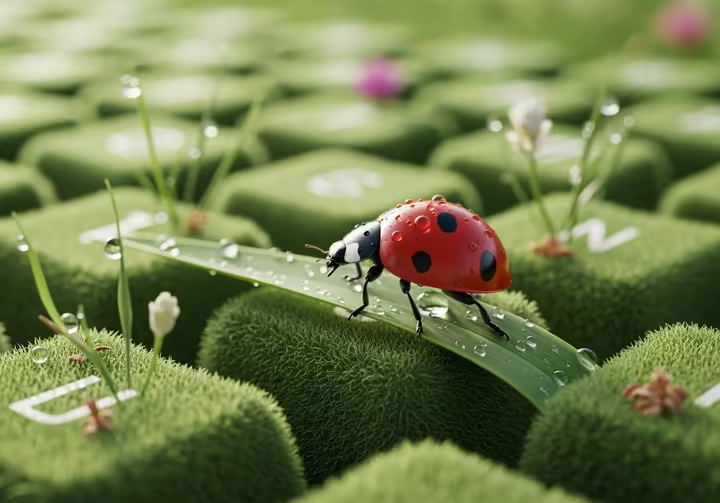
The Final Harvest
A Terraboard is designed to die. After 18-24 months, the grass and roots will naturally fail. This is the device's end-of-life, and it’s a stark contrast to the growing problem of e-waste.
Globally, millions of tons of e-waste are generated every year, leaching toxic materials into the ground. The Terraboard offers a different path. The "Final Harvest" begins by removing the only non-biodegradable parts: the microcontroller and the USB port.
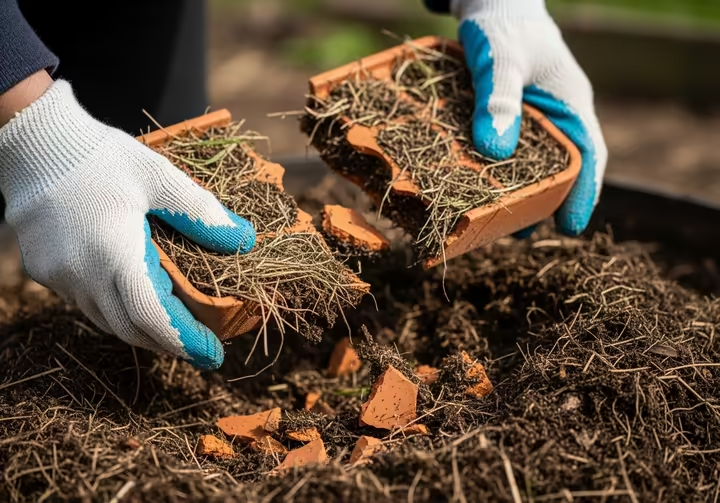
The rest of the assembly, the case, soil, and dead plant matter, goes right into the compost bin. It breaks down into nutrient-rich humus that can be used to enrich garden soil. Your keyboard gets a second life, a statement against the disposable nature of modern technology.
Works cited
- Developmental bioelectricity - Wikipedia, https://en.wikipedia.org/wiki/Developmental_bioelectricity
- Bioelectricity is a universal multifaced signaling cue in living organisms, https://www.molbiolcell.org/doi/10.1091/mbc.E23-08-0312
- Bioelectricity in plants: Laboratory Protocol University of Kentucky. 2022 Brock, Thomas, McLetchie & Cooper 1, https://web.as.uky.edu/biology/faculty/cooper/Plant%20Physiology/Electrophysiology%20lab-plants-2022-for%20class.pdf
- Electrical Signaling of Plants under Abiotic Stressors: Transmission of Stimulus-Specific Information - PMC - PubMed Central, https://pmc.ncbi.nlm.nih.gov/articles/PMC8509212/
- The Integration of Electrical Signals Originating in the Root of Vascular Plants - Frontiers, https://www.frontiersin.org/journals/plant-science/articles/10.3389/fpls.2017.02173/full
- pmc.ncbi.nlm.nih.gov, https://pmc.ncbi.nlm.nih.gov/articles/PMC10732603/#:~:text=The%20main%20electrical%20signals%20in,the%20system%20potential%20(SP).
- Biochemistry, Electron Transport Chain - StatPearls - NCBI Bookshelf, https://www.ncbi.nlm.nih.gov/books/NBK526105/
- Photosynthesis - The Cell - NCBI Bookshelf, https://www.ncbi.nlm.nih.gov/books/NBK9861/
- Mechanism of Electron Transport and Plant Energy Transport - Turito, https://www.turito.com/learn/biology/mechanism-of-electron-transport
- forages.oregonstate.edu, https://forages.oregonstate.edu/regrowth/how-does-grass-grow/developmental-phases/vegetative-phase/roots#:~:text=Two%20root%20systems%20exist%20for,the%20first%20season%20following%20planting.
- Grass Roots – Edge Right, https://edgeright.com/blogs/edge-right-blog/grass-roots
- Grass Roots, https://grassbarrier.com/pages/grass-roots
- Hand-Wiring Guide | QMK Firmware, https://docs.qmk.fm/hand_wire
- Perennial Ryegrass | NC State Extension Publications, https://content.ces.ncsu.edu/perennial-ryegrass
- www.monolithicpower.com, https://www.monolithicpower.com/en/learning/mpscholar/ac-power/grounding-practices/fundamentals-of-electrical-grounding#:~:text=Grounding%20systems%20have%20three%20main,also%20providing%20protection%20for%20them.
- Fundamentals of Electrical Grounding - Monolithic Power Systems, https://www.monolithicpower.com/en/learning/mpscholar/ac-power/grounding-practices/fundamentals-of-electrical-grounding
- www.lawnstarter.com, https://www.lawnstarter.com/blog/lawn-care-2/friable-loam-lawn-grass-soil/#:~:text=For%20grass%20and%20most%20other,lets%20excess%20water%20run%20through.
- How To Get Healthy Soil & Grow a Beautiful Lawn | Briggs & Stratton, https://www.briggsandstratton.com/na/en_us/support/maintenance-how-to/browse/how-to-get-healthy-soil-and-grow-a-beautiful-lawn.html
- www.troybilt.com, https://www.troybilt.com/en_US/knowledge-tb-how-to-grow-sod.html#:~:text=Fill%20the%20trays%20and%20plant,water%20the%20seeds%20as%20well.
- How to Grow Sod | Troy-Bilt | Troy-Bilt US, https://www.troybilt.com/en_US/knowledge-tb-how-to-grow-sod.html
- ANSI vs ISO Keyboard: Key Differences, Pros, & Which is Best ..., https://www.keychron.com/blogs/news/ansi-vs-iso-keyboard
- Keyboard layouts - What are QWERTY, ANSI and ISO? - iNVINTIX, https://invintix.com/en/sider/ulike-layout-oversikt
- Grafting | MU Extension, https://extension.missouri.edu/publications/g6971
- Building a Handwired Keyboard : 9 Steps - Instructables, https://www.instructables.com/Building-a-Handwired-Keyboard/
- Mechanical Keys Tutorial - GitHub Pages, https://joeyvigil.github.io/MechanicalKeys/tutorial
- MECHANICAL KEYBOARD - 69 KEY - 65% MML KEYBAR - Share Project - PCBWay, https://www.pcbway.com/project/shareproject/MECHANICAL_KEYBOARD_69_KEY_65_MML_KEYBAR_5c48f974.html
- Hand-Wired Keyboard Guide | Yaruki Zero Games, https://yarukizerogames.com/wp-content/uploads/2021/09/handwired-keyboard-guide.pdf
- AGR-251: Quick Identification Tips for Turfgrasses Commonly Grown in Kentucky - Extension Publications, https://publications.ca.uky.edu/files/AGR251.pdf
- Switches… There's so much choice So which switch is right for you? : r/DygmaLab - Reddit, https://www.reddit.com/r/DygmaLab/comments/yw3c81/switches_theres_so_much_choice_so_which_switch_is/
- List of Community Forums - Community - KeebTalk, https://www.keebtalk.com/t/list-of-community-forums/10539
- Thocky vs. Clacky: A Comprehensive Keyboard Sound Comparison - Lemon8 App, https://www.lemon8-app.com/@digitally.kate20/7469862946965914155?region=us
- clack and thock the only sound profiles available - what else is there : r/MechanicalKeyboards - Reddit, https://www.reddit.com/r/MechanicalKeyboards/comments/1lsqrty/clack_and_thock_the_only_sound_profiles_available/
- Tips for Troubleshooting Common Issues in DIY Electronics Projects, https://www.tomsonelectronics.com/blogs/news/tips-for-troubleshooting-common-issues-in-diy-electronics-projects
- Natural Pest Control for Your Lawn That Works (Hint: They're Not Homemade Recipes), https://www.lawnstarter.com/blog/lawn-care-2/natural-lawn-pesticides-that-work-hint-theyre-not-homemade-recipes/
- 5 Ways to Troubleshoot Your Electronics Circuit - KnowHow - Distrelec, https://knowhow.distrelec.com/stem/5-ways-to-troubleshoot-your-electronics-circuit/
- What Does "Thock" Mean? - Kinetic Labs, https://kineticlabs.com/blog/what-is-thock
- Creamy, Clacky, Thocky – Which Sound Profile Do You Prefer for Your Ke - Awekeys, https://awekeys.com/blogs/news/creamy-clacky-thocky-which-sound-profile-do-you-prefer-for-your-keyboard-choosing-the-right-switches-from-awekeys
- WC Sensory Words.docx, https://www.msjc.edu/learningresourcecenter/documents/writing-handouts/grammar/WC-Sensory-Words.pdf
- Lawn Maintenance | Month By Month Lawn Calendar - Perma Green, https://perma-green.com/lawn-maintenance-month-by-month-lawn-calendar/
- Seasonal Lawn Care Maintenance and Treatment Schedule - TruGreen, https://www.trugreen.com/lawn-care-101/blog/trugreen-lawn-care-services/lawn-maintenance-checklist
- Yearly Lawn-Care Schedule: A 365-Day Timeline, https://golfcourselawn.store/pages/365-day-lawn-care-schedule
- Global E-waste Statistics - EMEW, https://emew.com/blog/global-e-waste-statistics
- Electronic waste (e-waste) - World Health Organization (WHO), https://www.who.int/news-room/fact-sheets/detail/electronic-waste-(e-waste)
- Concepts of circular economy for sustainable management of electronic wastes - PubMed Central, https://pmc.ncbi.nlm.nih.gov/articles/PMC9970861/
- Backyard Composting Basics: A Cheatsheet - Rodale Institute, https://rodaleinstitute.org/blog/backyard-composting-basics-a-cheatsheet/
- Approaches to Composting | US EPA, https://www.epa.gov/sustainable-management-food/approaches-composting
- Garden Compost - Nebraska Extension Publications, https://extensionpubs.unl.edu/publication/g2222/na/html/view
- How circular economy models can address global e-waste | EY - US, https://www.ey.com/en_us/insights/climate-change-sustainability-services/how-circular-economy-models-can-address-global-e-waste
- The Benefits of a Circular Economy for Electronics - Altium Resources, https://resources.altium.com/p/circular-economy-for-electronics-benefits